Tom Clancy's Splinter Cell Chaos Theory First Look
Ubisoft throws open the kimono on Sam Fisher's latest well-lit multiplatform adventure.
Sustaining a franchise is arguably one of the biggest challenges faced by game developers. Once a game makes its (hopefully positive) debut, developers must begin the struggle to successfully follow it up, with their attention being divided between satisfying existing fans, gaining new ones, and evolving the original concept. Ubisoft's Splinter Cell series is one of best examples of doing this right. The first two installments in the series, the original Splinter Cell and its follow-up, Pandora Tomorrow, are smartly crafted stealth action games that walk the fine line between old and new.

The downside to this success is its tendency to create very high expectations for future installments. If there were ever a time that the Splinter Cell series could falter, it would be now, due to the high quality of its predecessors and the age of the current generation of consoles. Thankfully, Ubi's latest Splinter Cell, Chaos Theory, comes packing some stunning heat that will likely please and impress both fans and newcomers. We recently had a chance to meet with Ubi reps to receive both an update on where the game is at in development and a surprising demo of the PlayStation 2 game.
So how do you match or even surpass two top-notch offerings like Splinter Cell and Pandora Tomorrow? If you're Ubisoft's Montreal Studio, you just channel some of the insanity that was last tapped when crafting the second game, gathering a team of more than 100 people in Montreal and calling your 50 friends in Annecy, France, to create an incredibly promising game that expands on everything cool about Splinter Cell and then some. However, since everything we've seen on the game has focused on the PC and Xbox versions, you'd think the PlayStation 2 and GameCube editions would be pretty far behind. This is actually not the case. It seems that Ubi Montreal has another team roughly as big as the PC and Xbox group hard at work on the PlayStation 2 and GameCube versions. Although the GameCube version wasn't on hand, the work-in-progress PlayStation 2 version of the game showed that, while the PC and Xbox games look great, the other versions won't be slouches in the graphics department either.
But before we begin extolling the virtues of what we've seen, here's a quick recap of the game's story: Chaos Theory will once again be set just a bit in the future--2007, to be exact--and will star Sam Fisher, the salty combat veteran voiced with world-weary charm by Michael Ironside. This time out, the game's story finds Sam stopping yet another globe-threatening conspiracy. Of course, things don't start out that way. Sam is initially sent out to track down an individual with sensitive information and ensure he doesn't spill the beans. But when Sam discovers that the simple algorithm he's sent to keep under wraps can be used to crash stock markets, cause blackouts, and even hijack ballistic missiles, it's on.
The story will unfold as you progress through the game's levels, which will send you on an adventure around the globe. While this may sound like the previous entries in the series, it's anything but. Chaos Theory's structure has been crafted to be nonlinear and allow you freedom to choose just how you do your job. Although you might think this means there's just a second route to your objectives, there's quite a bit more to it. Your objectives will actually shift depending on how you choose to progress through the game. Some can even be cancelled out if you choose a course of action that nullifies them, such as killing someone you were supposed to interrogate. Seeing as dead men tell no tales, in such instances you'll be forced to get your info from another location, such as computer terminal.
The specific mechanics have been fleshed out some since Pandora Tomorrow, affording you more flexibility as you sneak about. Sam's move set has been expanded considerably, offering even more ways to kill. We got a peek at a satisfying array of stealth kills performed from a pleasing variety of positions, such as hanging from a ceiling, hanging off a ledge, and the old standby of snagging someone from behind. PlayStation 2 and GameCube owners can also rejoice at their exclusive stealth move: a water stealth kill wherein Sam grabs his foe and drowns him. Besides the new death-dealing moves, Sam will also have a "shoulder switch" that will let you change which hand is holding your gun on the fly.
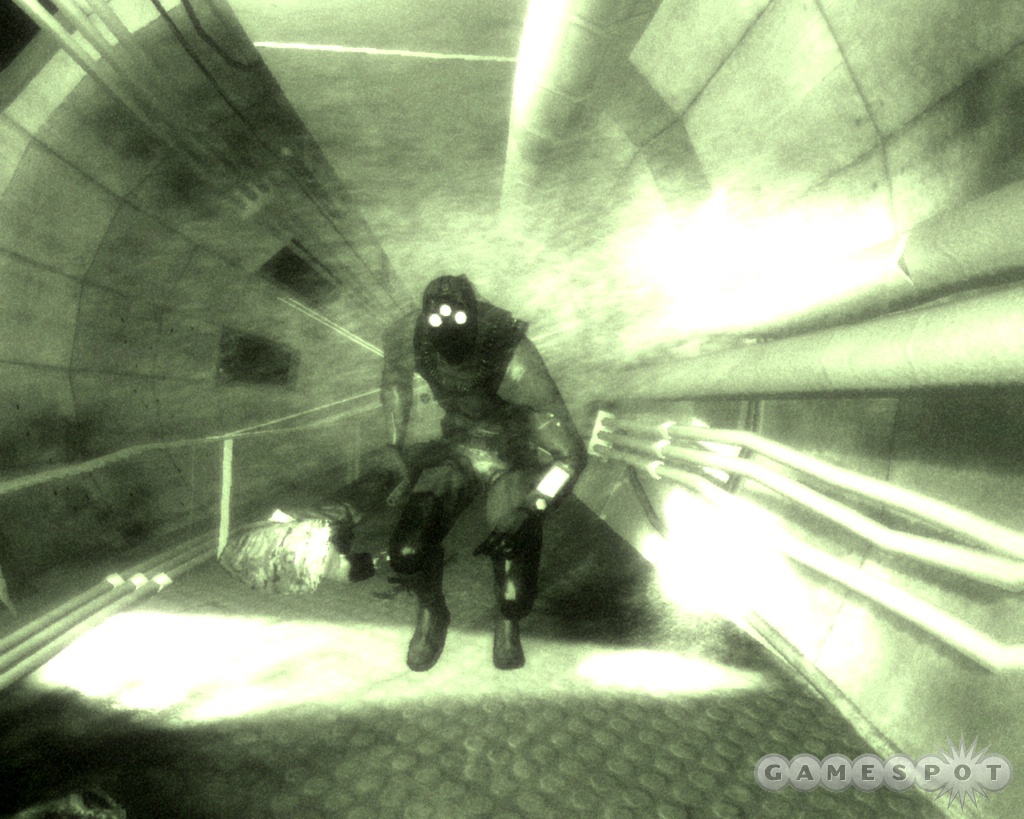
Sam's arsenal of weapons will vary according to how you decide to play through the game. At the start of each mission, you'll come to the new briefing screen, which will feature an assortment of talking heads that will vary per mission. Each person will offer some information on the task at hand, which should prove useful. Once you've gotten your fill of info, you'll go to a loadout screen that will let you decide what to take with you into the field. You'll have three basic configurations to choose from: stealth, assault, and Redding. The stealth package will lean more on gadgets and items to help you "ninja" your way to where you need to be. Assault leans toward ammo and firearms, as it will focus on running and gunning. Finally, Redding is the recommended assortment of weapons and gadgets as determined by William Redding, Sam's field runner. Once you've sorted your loadout, you'll be set loose for Sam's trademark sneaking and killing.
Walk Softly, Carry a Big Gun
Speaking of sneaking, you'll have to worry about more than just the light now--a new sound meter will keep you aware of how much noise you're making as you go about your business. As you'd expect, this is an important element of the stealth in Chaos Theory, as your foes will react to the sounds you make. The cool twist to this mechanic is that it also tracks ambient sound, so you can use it for "cover" as you go about your business. So, for example, if your sound meter reads a set level of ambient noise in the area you're in, denoted by a white mark on the meter, you'll be undetectable if you can keep the level of sound you make below that marker.
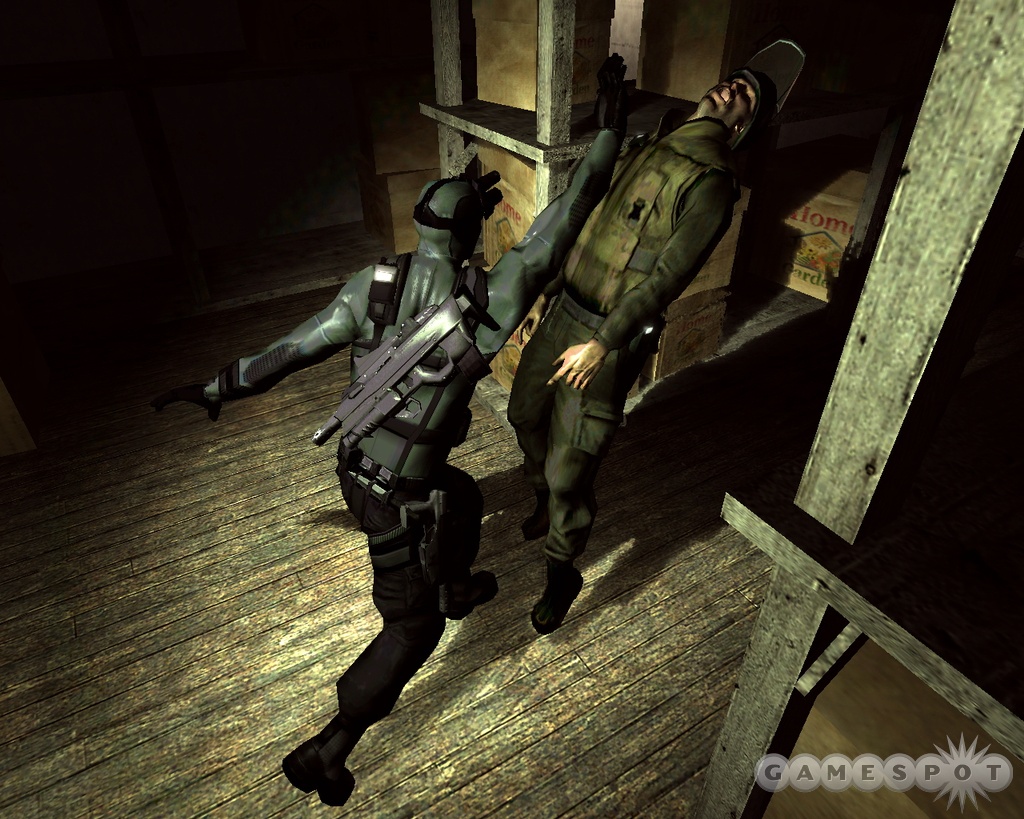
Besides the rich single-player experience, Chaos Theory will also offer multiplayer modes, something fans now expect from a Splinter Cell game, given how well Pandora Tomorrow's adversarial mode went down. Much like the single-player experience, which will be basically the same across all platforms (with some tweaks on each platform), Chaos Theory's multiplayer component will feature the same basic content but will have some modifications on each system. You'll find both co-op and adversarial modes. The co-op mode will feature a total of five missions: a tutorial and four proper missions that you can play with a friend. The mode will play out in third-person perspective like the single-player game, and the missions will run parallel to the action you encounter as Sam. The train-station level we saw demoed did a fine job of showing off just how slick the team mechanics are. You'll be able to interact with your buddy in a variety of ways. You can throw him across gaps and into enemies if you time it right, use him for a boost up to higher areas, have him help you rappel down to new areas, or even use him as a ladder.
You'll also find one co-op puzzle in each area that forces you to work in tandem. For example, one area requires the pair of you to defuse bombs you encounter together by cutting the correct wires in unison. Beyond that, some of the gadgets you'll use are now geared toward forcing you to work as a team with your teammate. For example, jamming electronics now requires you to remain stationary, making you a target. The AI will also present a hefty challenge that will require that you to work in tandem with a friend as you coordinate attacks and secure areas while working on your objectives. As far as specifics go, co-op will be split-screen on the PlayStation 2 and GameCube. The Xbox will offer split-screen, system link, and Xbox Live support. The PC version of the game will offer online and LAN play but thankfully will forgo split-screen.
The adversarial mode will offer a mix of old and new content wrapped in the same two-on-two mold as Pandora Tomorrow on the PC and Xbox. (The PS2 will feature its own unique adversarial mode, which we'll cover in a bit.) The mode's 11 maps will offer six all-new locales and five taken straight from Pandora's adversarial mode. The mechanics in the mode have been fleshed out quite a bit to make for a more compelling experience. You'll be able to perform some of the moves from co-op, such as throwing your teammate across gaps, the boost, and the human ladder. You'll also be able to heal a teammate, give him a gadget from your own pack, and remove spy devices from him, such as a spy bullet or spy trap.
In addition to this helpful stuff, you'll be able to perform fun and exciting new humiliation moves designed to totally annoy your opponent. Spies can now grab and kill enemy mercs when hanging upside down on a gangway. You'll grab them and snap their necks, during which time you can talk a world of smack. A personal favorite is the mercs' ability to smack a spy and daze him if he's rushing you. There will be some timing involved with the move, but it appears to offer a very satisfying result in the form of a dazed spy, which would appear to be a good setup for another merc move: finishing off a spy when he's on the ground. If you happen to see a spy on the ground, you'll be able to choke the life out of him, which looks pretty cool.
Unfinished Business
Beyond your own personal skills, Chaos Theory's multiplayer will also throw in some cool new gadgets for you to use. Spies will receive a thermoptic camo suit that lets them become virtually invisible for a stretch of time. They'll also receive the heartbeat detector, which will let you check your surroundings for people you can't see. While both gadgets are cool, mercenaries have a greater number of new toys to rock in Chaos Theory. The network browsing device allows mercenaries to tap into local camera networks and make use of the mercenary-detection tools such as the assorted vision modes, and they also have a torch and a laser.
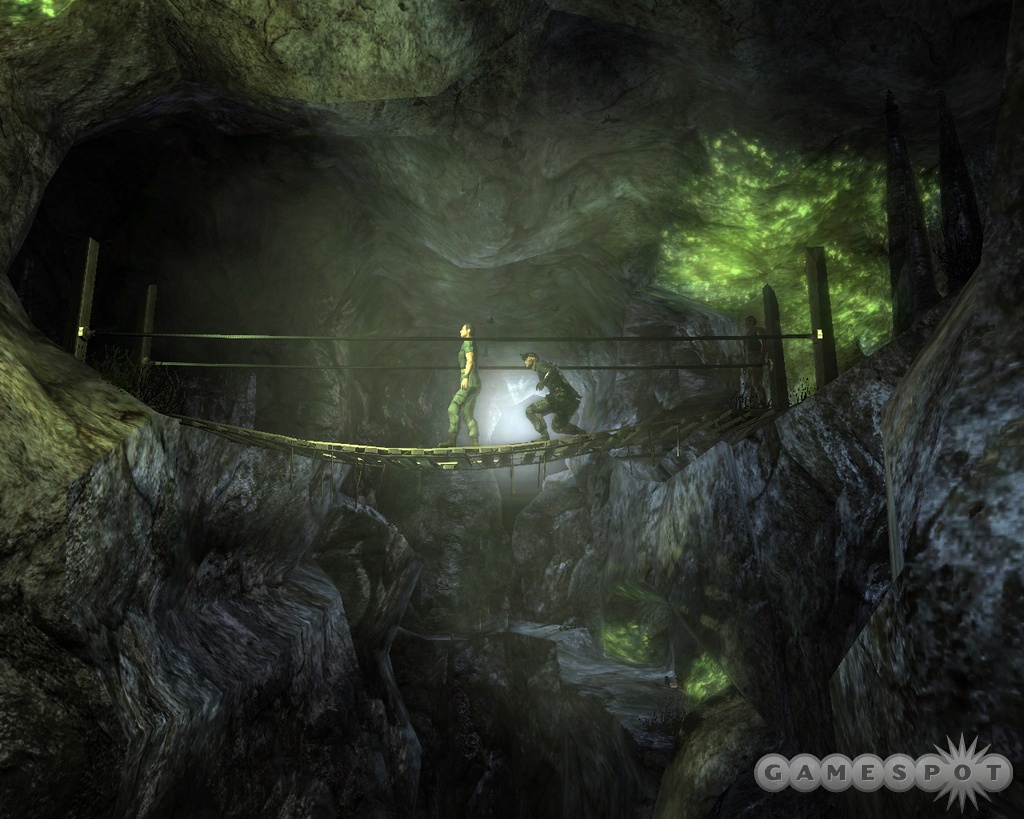
The catch is that while using the camera, you're vulnerable to attack. The gas mask will let mercs shrug off toxic gas attacks for a short time. A backpack will feature a portable stash of gadgets to share with your teammate. Finally, a poison mine will poison any spy who triggers it. As far as weapons go, mercs will now pack a shotgun that's excellent at close range, a submachine gun that has a high rate of fire that results in a spray, and an assault gun that's similar to an assault rifle with a lower rate of fire than an Uzi, but with a higher rate of damage.
The new additions to the merc and spy arsenals are actually complemented by tweaks made to the existing array of items from Pandora Tomorrow. Spies can now use sticky cameras to create their own camera network, allowing you to toggle between cameras and retrieve cameras that have already been placed. Flares have been retuned to just give off one burst of light that quickly disappears. The merc spy trap can be modified to be a motion detector that you can set to mark a target or alert you if a foe is near it.
You'll be able to use all your toys in three different game types: story, disk hunt, and deathmatch. Story will feature three types of objectives--neutralization, extraction, and bombing--that you'll have to complete in the face of opposition. Neutralization objectives will require that you find a keyboard and access it to trigger changes in the level. Extraction requires you to find a data disk and get it to your attaché case for uploading. Finally, bombing requires you to destroy objects by planting bombs. The catch is that mercs can defuse your handiwork if you're not around to watch it.
Disk hunt requires spies to collect a certain number of disks spread out randomly through a level without getting murdered by mercs. If you're taken out after collecting disks, your stash will be where you were dropped.
Finally, deathmatch is a challenging fight to the death between mercs and spies that has some tough restrictions. Spies can only have a flashbang and mercenaries can only have a flare. Mercs can't use EMF vision, movement vision, or their laser sight--just their torch. Also, mercs will lose the ability to swat away spies who are rushing at them. If this all sounds a bit too harsh for your tastes, you can use the game's alternate-rules option and tweak your own match parameters. The mode will also have some neat twists to it, thanks to destructible elements in the environment that let you access new areas and essentially change the level layout.
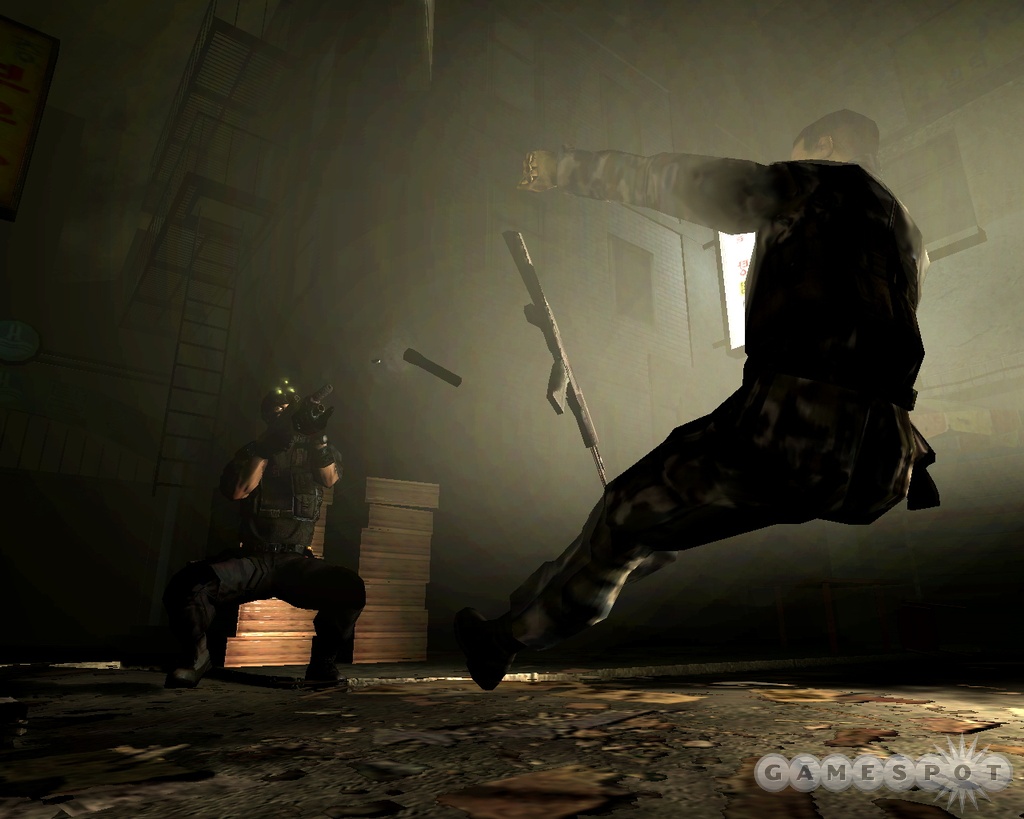
Sound too complicated? Don't fret. The game will offer tutorials for the core mechanics, as well as additional support when you're in the game, such as help paths that help ease you into navigating the levels. The in-game HUD has also been tweaked to make keeping tabs on what's going on a bit easier. The game provides a tactical map that shows the different zones, which can be helpful for getting your bearings and planning your next move. For those who really want to hone their skills, you'll be able to create tutor sessions where you and your opponents can actually talk to each other and familiarize yourself with the game's systems, which is perfect for easing new players into the cutthroat adversarial experience. Also easing the curve will be the game's assisted matchmaking system, which will group you with players who have logged in as much time as you have, much like Halo 2's matchmaking system, albeit a bit simpler.
You'll also notice a Halo 2 influence in some of the game's other features, such as the ability to send voice messages, and the ability to create or join customizable clans--you can even throw down challenges for interclan matches. Finally, the game will include a ranking system that will keep players who are at level one with zero points from losing any if things go awry.
A Dark Beauty
Hopefully PlayStation 2 owners haven't gotten superenthused about the above-mentioned adversarial-mode features, as Chaos Theory's adversarial mode on the PS2 is a bit different. The mode will actually be based on Pandora Tomorrow's adversarial mode and lack the new features and gadgets seen in the PC and Xbox versions. What PS2 owners can expect is a mode that stays true to the Pandora Tomorrow experience, with all the maps from that game and four new ones. While this probably isn't what PS2 owners want to hear after our poetic waxing on the new content for the PC and Xbox, the bottom line is that Pandora Tomorrow had solid online play. If Chaos Theory for the PS2 is able to offer a few new maps, it's still a cut above the complete lack of adversarial gameplay that GameCube owners will have to make peace with.
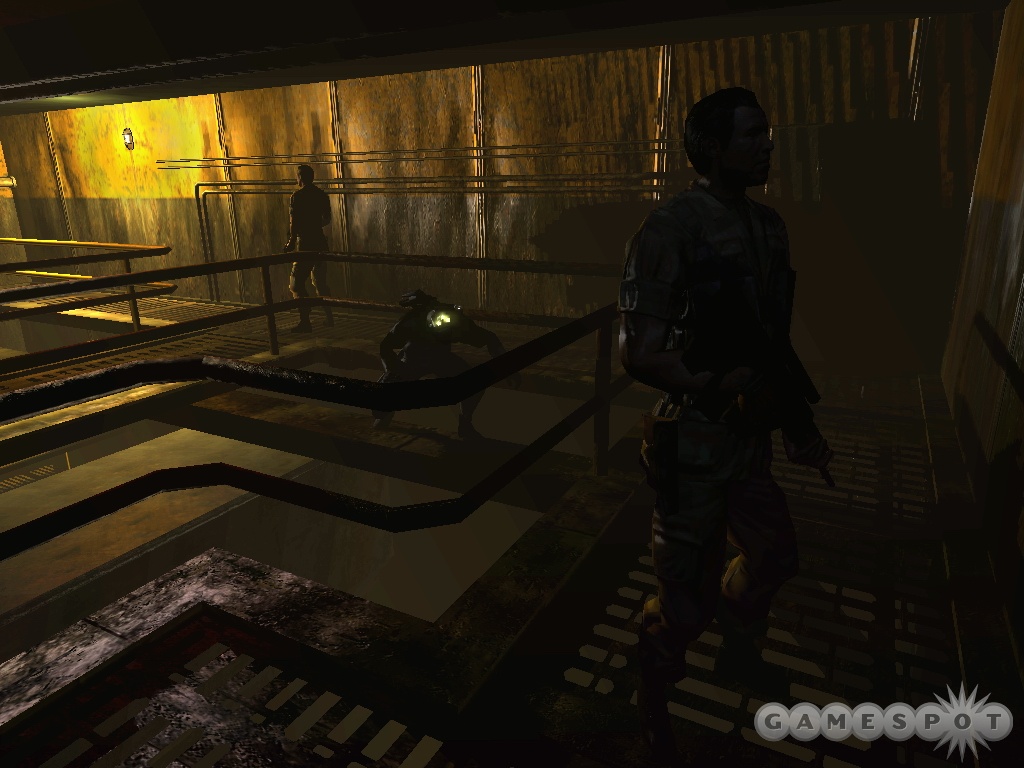
Given the compromise to the PS2's adversarial mode, you might be thinking that the single-player mode's graphics will also be noticeably lacking in comparison with the jaw-dropping graphics seen on the PC and Xbox. Think again. Thanks to a hefty amount of R&D, and probably some sacrificial offering to the god of PS2 graphics, Chaos Theory for the PS2 looks remarkably close to its Xbox counterpart, despite the fact that the work-in-progress version of the game that we saw was several weeks behind the Xbox version also on display. Ubisoft Montreal's crack team of developers has managed to re-create much of the appearance of its shiny, normal-mapped Xbox cousin to impressive effect. An all-new engine has allowed the team to nail the visual staples such as specular highlights, dramatic lighting, and detailed textures quite nicely. At the same time, the robust engine has managed to coax more performance out of the PlayStation 2, resulting in some stunning light-refraction effects that make for impressive views through warped glass and heat effects.
More importantly, a newly created technique, dubbed "geo texturing," has allowed Chaos Theory to mimic the normal mapping on the Xbox using a real-time 3D mesh that's textured on the fly. The end result is the same look as the Xbox's normal maps, done in real 3D, which doesn't tax the PS2 as much as traditional techniques would. The cherry on top of the whole package is a stunning new water effect that is quite possibly the most stunning water we've seen on the PS2 to date--yes, even better than the water in Splashdown and Baldur's Gate. The effect is actually more dynamic than what we've seen on the PC and Xbox versions and features waves and ripples that naturally react to movement. While there were obviously some rough spots to the game's frame rate, what we've seen so far has us hopeful and more than a little excited to see the final product. If the frame rate can be locked down, Chaos Theory should be one amazing-looking PS2 game when it hits.
The audio in the prerelease version of the game that we saw was a placeholder, with just bits and pieces of music and a meaty chunk of voice on top of the environmental and weapon sounds you'd expect to hear. Still, Chaos Theory's audio sounds more robust than Pandora's already, and features a good variety of enemy chatter that you'll hear as you slink around. We're also fans of some of the one-liners that Sam and his foes spout from time to time. Although it's still rough, we're certainly pleased with the direction that the audio in Chaos Theory is headed.
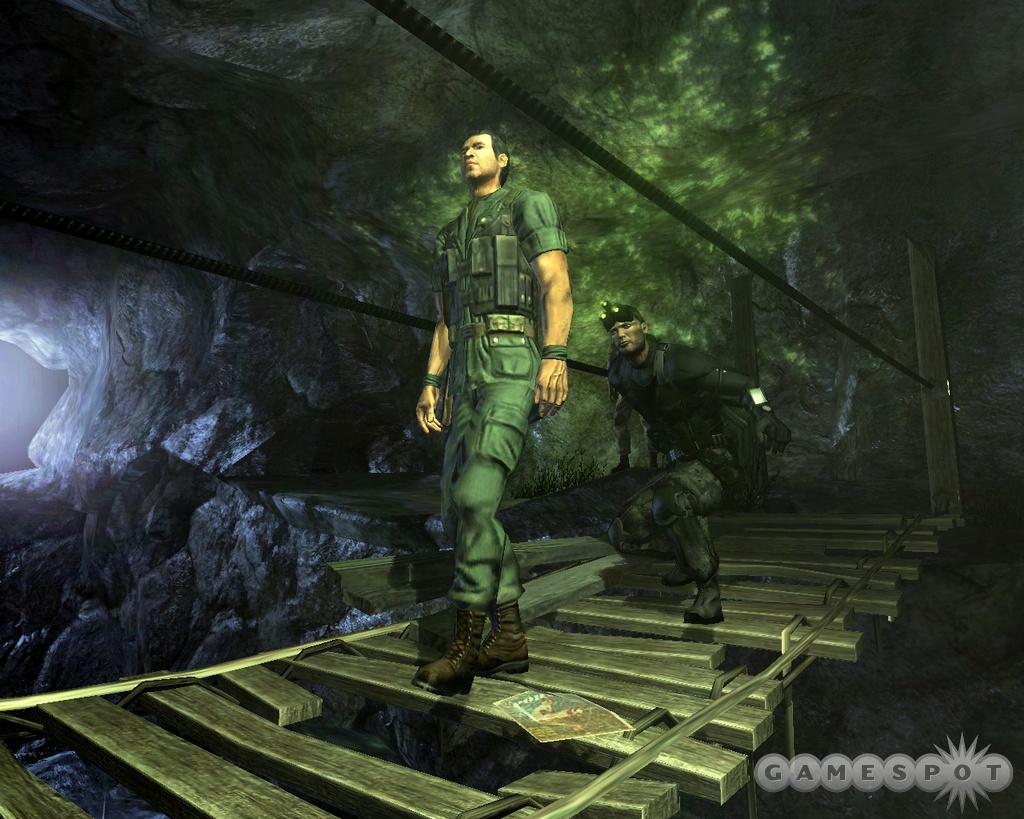
At this point we'd like to think that there's little doubt that Splinter Cell Chaos Theory will be one to watch when it hits this March. The game's eye-popping visuals are matched by solid gameplay and engaging multiplayer options. Like its predecessor, the game is anything but a cookie-cutter sequel that's been quickly cranked out. Ubi Montreal and Ubi Annecy appear to be firing on all pistons once again, which means good things for Chaos Theory. Splinter Cell Chaos Theory is slated to ship this March for the GameCube, PC, PlayStation 2, and Xbox. Look for more on the game soon.
Got a news tip or want to contact us directly? Email news@gamespot.com
Join the conversation